VBA Excel
Excel is a Microsoft application used to work with spreadsheets. VBA is embedded in the Excel application and can be used to work programmatically with Excel. The Excel Object Library contains classes that make working with Excel in VBA possible. The classes in the Excel Object Library are referred to as the Excel Object Model. When using VBA within Excel, a reference is automatically included to the Excel Object Library.
Excel Object Model
The Excel Object Model contains classes that make working with Excel in VBA possible. The Excel Object Model contains many classes but the general overview of the Excel Object Model is Application → Workbook → Worksheet → Range.
*The VBProject class is defined in the VBIDE library but is a property of the Workbook object.
**The FileDialog class is defined in the Office library but is a property of the Excel.Application object.
Context
The place where VBA code is written determines the implied context when referring to classes. For example, when using VBA in Excel and referring to the Application object, it is implied that Application and Excel.Application are the same object. However, when using VBA in another application to work with Excel, it is necessary to qualify references to avoid naming collisions with classes in the other application. Using qualified references requires that a reference is set to the library where the classes are defined. If a reference cannot be set, late-binding can be used instead.
Public Sub Example()
'''In Excel
Debug.Print Application Is Excel.Application 'Prints: True
End SubPublic Sub Example()
'''In Outlook
'Reference to Excel Object Library is required
Debug.Print Application Is Excel.Application 'Prints: False
Debug.Print Application Is Outlook.Application 'Prints: True
End SubTo retrieve the Excel Application object from another application, attempt to retrieve the running application and if that fails start a new instance of the application.
Public Function GetExcelApp() As Object
On Error Resume Next
Set GetExcelApp = GetObject(, "Excel.Application")
On Error GoTo 0
If GetExcelApp Is Nothing Then
Set GetExcelApp = CreateObject("Excel.Application")
End If
End FunctionApplication
The Application object is the top-level object in the Excel Object Model which represents the Excel Application itself. The Application object contains information, settings, and functionality of the Excel application.
Application-Level Settings
Certain properties of the Application object can be changed which alters the way Excel behaves. These properties can sometimes be set manually from the Options menu or programmatically with VBA.
The ScreenUpdating property can be set to False to prevent the screen from updating while a macro is running. Then it can be set back to True to allow the updates to take place. Disabling screen updating while a macro is running can improve performance and speed as well as prevent the screen from flickering while code is executing.
The EnableEvents property can be set to False to prevent events from being triggered when a macro is running. At times it is necessary to disable events to avoid infinite loops. Other times it may be unnecessary for events to be running while code is executing. Set the property back to True at the end of the macro to re-enable normal event behavior.
The DisplayAlerts property can be set to False to prevent Excel alert messages from popping up while a macro is running. The property should be set back to True at the end of the macro to allow Excel pop-up alerts.
The Calculation property can be set to prevent formulas from recalculating while a macro is running. In Excel there are volatile functions that update whenever any change is made on the worksheet. This can be unnecessary and very inefficient. After the macro finishes running the Calculate method can be called on the sheet and the Calculation property can be set to xlCalculationAutomatic.
Public Sub Example()
Application.ScreenUpdating = False
Application.EnableEvents = False
Application.DisplayAlerts = False
Application.Calculation = xlCalculationManual
'Code statements
Application.Calculation = xlCalculationAutomatic
Application.DisplayAlerts = True
Application.EnableEvents = True
Application.ScreenUpdating = True
End SubWorksheetFunction
The WorksheetFunction object can be used to call Excel spreadsheet functions in VBA.
Public Sub Example()
Dim TheSum As Double
TheSum = Application.WorksheetFunction.Sum(1, 2, 3, 4, 5)
End SubRun
The Run method is used to call a procedure based on a string representing the procedure's name. The Run method can be used to call a procedure in a similar way to a callback function.
Option Explicit
Public Sub Example()
Dim Arr(0 To 9) As Long
Arr(0) = 1
Arr(1) = 2
Arr(2) = 3
Arr(3) = 4
Arr(4) = 5
Arr(5) = 6
Arr(6) = 7
Arr(7) = 8
Arr(8) = 9
Arr(9) = 10
OperateOnValues Arr, "Square"
PrintArray Arr
End Sub
Public Sub OperateOnValues(Arr As Variant, Callback As String)
Dim i As Long
For i = LBound(Arr) To UBound(Arr)
Arr(i) = Application.Run(Callback, Arr(i))
Next i
End Sub
Public Function Square(Num As Long) As Long
Square = Num * Num
End Function
Public Sub PrintArray(Arr As Variant)
Dim i As Long
For i = LBound(Arr) To UBound(Arr)
Debug.Print Arr(i)
Next i
End SubEvaluate
The Evaluate method can be used to evaluate formulas, cell references, chart elements, and form controls. Square bracket syntax, [expression], can be used instead of using Application.Evaluate(expression). Evaluate can evaluate worksheet formulas that return an array and it can evaluate array literals.
Public Sub Example()
'Evaluate range reference
Debug.Print Application.Evaluate("A1").Value2
Debug.Print [A1].Value2
'Evaluate worksheet formula
Debug.Print Application.Evaluate("Sum(1, 2, 3, 4, 5)")
Debug.Print [Sum(1, 2, 3, 4, 5)]
'Evaluate array literal
Dim Arr()
Arr = Application.Evaluate("{1,2,3;4,5,6;7,8,9}")
Arr = [{1,2,3;4,5,6;7,8,9}]
Debug.Print Arr(1, 1)
Debug.Print Arr(1, 2)
Debug.Print Arr(1, 3)
Debug.Print Arr(2, 1)
Debug.Print Arr(2, 2)
Debug.Print Arr(2, 3)
Debug.Print Arr(3, 1)
Debug.Print Arr(3, 2)
Debug.Print Arr(3, 3)
End SubUnion
The Union method is used to combine two or more ranges into a single Range object. The ranges do not need to be contiguous.
Public Sub Example()
Dim Rng As Range
Set Rng = Union(Range("A1"), Range("A2")) 'Contiguous Range
Rng.Interior.Color = vbRed
Set Rng = Union(Range("C1"), Range("C3")) 'Noncontiguous Range
Rng.Interior.Color = vbGreen
End SubIntersect
The Intersect method returns the Range where two or more Ranges intersect. If none of the Ranges intersect the method returns Nothing. If Ranges from more than one Worksheet are passed, an error occurs.
Public Sub IntersectingRanges()
Dim WS As Worksheet
Set WS = Activesheet
Dim R1 As Range
Set R1 = WS.Range("A1:C5")
Dim R2 As Range
Set R2 = WS.Range("C1:E5")
Dim I As Range
Set I = Application.Intersect(R1, R2)
If I Is Nothing Then
Debug.Print "Ranges do not intersect."
Else
Debug.Print I.Address
End If
End SubVolatile
The Volatile method is used to make a User-Defined Function volatile. Volatile functions are recalculated whenever any change occurs on the Worksheet.
Public Function AddTwoNumbers(Num1 As Double, Num2 As Double) As Double
Application.Volatile
AddTwoNumbers = Num1 + Num2
End FunctionSendKeys
The SendKeys method is used to send keyboard keys to the active application.
Public Sub Example()
'Add text to the first cell
Application.SendKeys "^{HOME}"
Application.SendKeys "Hello, World!"
Application.SendKeys "{ENTER}"
End SubOnKey
The OnKey method is used to assign a macro to a keyboard key.
Public Sub Example()
'Assign keyboard shortcut
Application.OnKey "^a", "DisplayMessage"
'Disable keyboard shortcut
Application.OnKey "^a", ""
'Return keyboard shortcut to default
Application.OnKey "^a"
End Sub
Public Sub DisplayMessage()
Msgbox "Hello, World"
End SubInputBox
The InputBox method is used to display an input box and get user input. Acceptable data types can be specified by the Type parameter.
Public Sub Example()
Dim UserInput
UserInput = Application.InputBox("Enter Number", Type:=1 + 2) 'Accepts Number or Text
Debug.Print UserInput
End SubSpeech
The Speech object can be used to make Excel talk.
Public Sub Example()
Application.Speech.Speak "Hello World"
End SubFileDialog
The FileDialog property is used to create a FileDialog object which users can use to select files and folders from the file system.
Public Sub Example()
'Get file path from file picker FileDialog
Dim FD As FileDialog
Set FD = Application.FileDialog(msoFileDialogFilePicker)
With FD
.AllowMultiSelect = False
If .Show Then
Debug.Print .SelectedItems(1)
Else
Debug.Print "No file selected."
End If
End With
End SubDialogs
The Dialogs property is used to create a Dialog object object which can represent dialog windows.
Public Sub Example()
'Get color from EditColor Dialog
Dim ColorIndex As Long
Dim EditColor As Dialog
Dim Result As Boolean
Dim ColorValue As Long
ColorIndex = 56
Set EditColor = Application.Dialogs(xlDialogEditColor)
Result = D.Show(ColorIndex)
ColorValue = ThisWorkbook.Colors(ColorIndex)
Debug.Print ColorValue
End SubProperties
There are a number of useful properties that can be used to get information about the Excel application and the user's platform.
The PathSeparator property returns the path separator character for the user's system. On Windows this will be a "\" and on Mac this will be a "/".
The OperatingSystem property returns a string describing the user's operating system.
The UserName property returns the UserName of the Excel user.
Windows
The Window object represents a window. The Windows collection object contains a collection of Window objects and can be accessed through the Application.Windows property. The Window object can be used to control various settings and features of windows in Excel. Some properties that can be controlled are Split, FreezePanes, DisplayGridlines, and DisplayFormulas.
Public Sub Example()
'Toggle Gridlines
Dim WS As Worksheet
Set WS = ActiveSheet
WS.Activate
Dim W As Window
Set W = Application.ActiveWindow
W.DisplayGridlines = Not W.DisplayGridlines
End SubWorkbooks
The Workbook object represents an Excel Workbook. The Workbooks collection object contains all open Workbooks under the Excel Application. To access the Workbooks collection use the Application.Workbooks property.
Referring to Workbooks
To refer to a Workbook, use the workbook's Name or Index in the Workbooks collection. When referring to a Workbook by name, the file extension may be required if file extensions are shown on the user's system in the File Explorer. Workbook indexes start at 1.
Public Sub Example()
Dim WB As Workbook
Set WB = Workbooks("Example.xlsx")
Set WB = Workbooks(1)
End SubEvery Workbook has its own VBA Project associated with it. To reference the Workbook containing the VBA Project where the code is running, use the ThisWorkbook property.
Public Sub Example()
Dim WB As Workbook
Set WB = ThisWorkbook
End SubIterating Over Workbooks
A For Next or For Each loop can be used to iterate over the Workbooks collection.
Public Sub Example()
Dim i As Long
For i = 1 To Workbooks.Count
Debug.Print Workbooks(i).Name
Next i
Dim WB As Workbook
For Each WB In Workbooks
Debug.Print WB.Name
Next WB
End SubOpen Workbook
To Open a Workbook use the Workbooks.Open method.
Public Sub Example()
Dim WB As Workbook
Set WB = Workbooks.Open("C:\Example.xlsx")
End SubAdd Workbook
To create a Workbook use the Workbooks.Add method.
Public Sub Example()
Dim WB As Workbook
Set WB = Workbooks.Add
End SubSave Workbook
To save a Workbook use the Workbook.SaveAs and Workbook.Save methods. Use the XlFileFormat enum to determine the file format to use when saving.
Public Sub Example()
Dim WB As Workbook
Set WB = Workbooks.Add
WB.SaveAs "C:\Example.xlsx", xlWorkbookDefault
WB.Range("A1").Value2 = "Hello, World!"
WB.Save
End SubClose Workbook
To close a Workbook use the Workbook.Close method.
Public Sub Example()
Dim WB As Workbook
Set WB = Workbooks.Open("C:\Example.xlsx")
WB.Close
End SubWorksheets
The Worksheet object represents a Worksheet within a Workbook. The Worksheets collection object contains a collection of all Worksheets within a given Workbook. Use the Workbook.Worksheets property to access the Workbooks collection.
Referring To Worksheets
Worksheets can be referenced from the Worksheets collection by the Name property, Index property, or CodeName property. The Name and CodeName appear side by side in the project explorer in the Visual Basic Editor. The Name property is the name that appears on the sheet tab in Excel. The CodeName property can be set in the properties window for the Worksheet object. If a Worksheet is referred to by its Name or Index, the sheet may be moved or renamed which can break code that relies on these properties. It may be better when possible to set the CodeName property of Worksheets in the Visual Basic Editor and refer to sheets by CodeName.
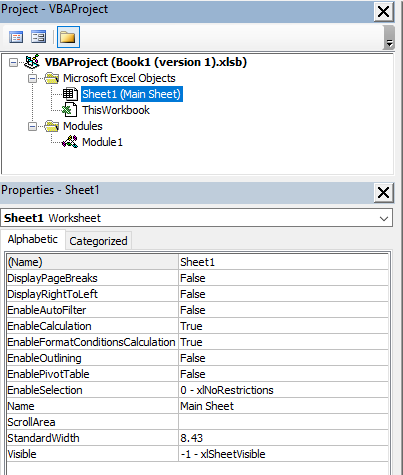
Public Sub Example()
Dim WS As Worksheet
Set WS = Worksheets("Main Sheet") 'Name
Set WS = Worksheets(1) 'Index
Set WS = Sheet1 'CodeName
Debug.Print WS.Name
Debug.Print WS.Index
Debug.Print WS.CodeName
End SubIterating
A For Next or For Each loop can be used to iterate over the the Worksheets collection.
Public Sub Example()
Dim i As Long
For i = 1 To Worksheets.Count
Debug.Print Worksheets(i).Name
Next i
Dim WS As Worksheet
For Each WS In Worksheets
Debug.Print WS.Name
Next WS
End SubAdd
Worksheets can be added to a Workbook using the Worksheets.Add method.
Public Sub Example()
'Add Worksheet after last sheet
Dim WB As Workbook
Dim WS As Worksheet
Set WS = WB.Worksheets.Add(After:=WB.Worksheets(WB.Worksheets.Count))
End SubCopy
To copy a Worksheet use the Worksheet.Copy method.
Public Sub Example()
Dim WB As Workbook
Set WB = ThisWorkbook
Dim WS As Worksheet
Set WS = WB.Worksheets(1)
Dim WSCopy As Worksheet
Set WSCopy = WS.Copy(After:=WB.Worksheets(WB.Worksheets.Count))
End SubMove
To move a Worksheet use the Worksheet.Move method.
Public Sub Example()
Dim WB As Workbook
Set WB = ThisWorkbook
Dim WS As Worksheet
Set WS = WB.Worksheets(WB.Worksheets.Count)
WS.Move Before:=WB.Worksheets(1)
End SubDelete
To Delete a Worksheet use the Worksheet.Delete method. When a sheet is deleted an alert pops up warning that the sheet will be permanently deleted. To prevent this pop-up, disable alerts by setting the Application.DisplayAlerts property to False. After the sheet is deleted, alerts can be re-enabled by setting the property to True.
Public Sub Example()
'Suppress alert that sheet will be deleted permanently
Application.DisplayAlerts = False
WS.Delete
'Unsuppress alerts
Application.DisplayAlerts = True
End SubNaming
The Worksheet.Name property represents the worksheet name displayed on the sheet tab in Excel. The Worksheet.CodeName property represents the Worksheet object's name in code and can be used directly in code as an object variable.
Public Sub Example()
Dim WB As Workbook
Set WB = ThisWorkbook
Dim WS As Worksheet
Set WS = WB.Worksheets.Add(After:=WB.Worksheets(WB.Worksheets.Count))
WS.Name = "Main"
Debug.Print WS.Name
Debug.Print WS.CodeName
End Sub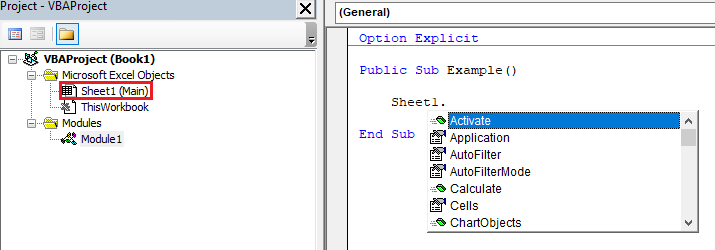
If the Worksheet name is already taken an error will occur. It may be necessary to create a function to name a Worksheet which handles naming collisions.
Option Explicit
Public Sub Example()
Dim WS As Worksheet
Set WS = ThisWorkbook.Worksheets.Add
NameWorksheet WS, "Test"
Set WS = ThisWorkbook.Worksheets.Add
NameWorksheet WS, "Test"
End Sub
Public Sub NameWorksheet(WS As Worksheet, WSName As String)
Dim WSName1 As String
WSName1 = WSName
Dim WB As Workbook
Set WB = WS.Parent
Dim WSs As Sheets
Set WSs = WB.Worksheets
Dim WSCount As Long
WSCount = WSs.Count
Dim IsNamed As Boolean
Dim c As Long
Do While Not IsNamed
Dim NameFound As Boolean
NameFound = False
Dim i As Long
For i = 1 To WSCount
If WSName1 = WSs(i).Name Then
NameFound = True
Exit For
End If
Next i
If NameFound Then
c = c + 1
WSName1 = WSName & " (" & c & ")"
Else
WS.Name = WSName1
IsNamed = True
End If
Loop
End SubRanges
The Range object represents a range of cells on a Worksheet.
Cells Property
The Worksheet.Cells and Range.Cells properties can be used to return a Range object given a row and column index. With the Worksheet.Cells property the row and column indexes are relative to the entire worksheet. With the Range.Cells property the row and column indexes are relative to the Range. The Cells property is useful when iterating over rows and columns.
Public Sub Example()
Dim WS As Worksheet
Set WS = ThisWorkbook.Worksheets(1)
Dim i As Long
For i = 1 To 10
WS.Cells(i, 1).Value2 = i
Next i
End SubPublic Sub Example()
Dim Rng As Range
Set Rng = ThisWorkbook.Worksheets(1).Range("B11:B20")
Dim i As Long
For i = 1 To 10
Rng.Cells(i, 1).Value2 = i
Next i
End SubCell Values
The Value property of the Range object returns the value stored in a cell.
The Value2 property of the Range object returns the value stored in a cell. Currency and Date types are returned as their underlying numerical values and not the correctly formatted Currency or Date.
The Text property of the Range object returns the text that is currently displayed in the cell.
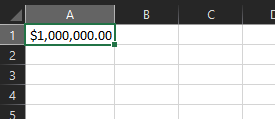
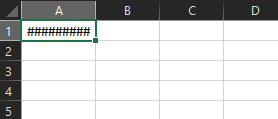
Public Sub Example()
'Prints 1000000, Currency
Debug.Print Range("A1").Value, TypeName(Range("A1").Value)
'Prints 1000000, Double
Debug.Print Range("A1").Value2, TypeName(Range("A1").Value2)
'Prints $1,000,000.00, String
'Prints #########, String
Debug.Print Range("A1").Text, TypeName(Range("A1").Text)
End SubFormulas
The Formula and FormulaR1C1 properties can be used to add or read the formula in a cell. The Formula property uses A-1 style cell referencing and the FormulaR1C1 property uses R1C1 style cell referencing.
Public Sub Example()
Range("B1").Formula = "=SUM($A$1:$A$10)"
Range("B1").FormulaR1C1 = "=SUM(RC[-1]:R[9]C[-1])"
End SubCopy and Paste
Ranges can be copied and pasted using the Copy method and the PasteSpecial method.
Public Sub ExampleRange()
'Copy directly
Range("A1").Copy Range("B1")
'Copy and paste
Range("A1").Copy
Range("B1").PasteSpecial xlPasteValues
End SubFormatting
The Interior object allows properties related to the Range's interior color to be set. Use the Range.Interior property to get the Interior object for a Range.
The Font object allows properties about a Range's font to be set. Use the Range.Font property to get the Font object for a Range.
The Borders object allows properties about a Range's borders to be set. Use the Range.Borders property to get the Borders object for a Range.
Public Sub Example()
With Range("A1")
With .Interior
.Color = vbRed
End With
With .Font
.Bold = True
.Italic = True
End With
With .Borders
.LineStyle = xlContinuous
.Color = vbBlue
End With
End With
End SubConditional Formatting
The FormatConditions object is used to add Conditional Formatting to a Range. Use the Range.FormatConditions property to get the FormatConditions object for a Range.
Public Sub Example()
'Highlight Duplicates
With Range("A:A")
.FormatConditions.AddUniqueValues
.FormatConditions(.FormatConditions.Count).SetFirstPriority
.FormatConditions(1).DupeUnique = xlDuplicate
With .FormatConditions(1).Font
.Color = -16383844
.TintAndShade = 0
End With
With .FormatConditions(1).Interior
.PatternColorIndex = xlAutomatic
.Color = 13551615
.TintAndShade = 0
End With
.FormatConditions(1).StopIfTrue = False
End If
End SubNumberFormat
The NumberFormat property is used to set the data type of a range. The format codes for the NumberFormat property are the same codes as the codes in the Format Cells dialog in Excel.
| Format | Format Code |
|---|---|
| General | "General" |
| Number | "0.00" |
| Currency | "$#,##0.00" |
| Accounting | "_($* #,##0.00_);_($* (#,##0.00);_($* ""-""??_);_(@_)" |
| Short Date | "m/d/yyyy" |
| Long Date | "[$-x-sysdate]dddd, mmmm dd, yyyy" |
| Time | "[$-x-systime]h:mm:ss AM/PM" |
| Percentage | "0.00%" |
| Fraction | "# ?/?" |
| Scientific Notation | "0.00E+00" |
| Text | "@" |
| ZIP Code | "00000" |
| ZIP Code + 4 | "00000-0000" |
| Phone Number | "[<=9999999]###-####;(###) ###-####" |
| Social Security Number | "000-00-0000" |
Public Sub Example()
'Format cell as Text
Range("A1").NumberFormat = "@"
End SubCurrentRegion
The CurrentRegion property can be used to reference a region of rows and columns where there is connected data. The intersection of a blank row and a blank column divides regions.

Public Sub Example()
Dim Rng As Range
Set Rng = Range("A1").CurrentRegion
Debug.Print Rng.Address 'Prints $A$1:$C$4
End SubResize
The Resize property is used to resize a Range object. The Resize property can be used to resize ranges so that arrays can be directly assigned to the range.
Public Sub Example()
Dim Arr(0 To 2, 0 To 2) As Long
Arr(0, 0) = 1
Arr(0, 1) = 2
Arr(0, 2) = 3
Arr(1, 0) = 4
Arr(1, 1) = 5
Arr(1, 2) = 6
Arr(2, 0) = 7
Arr(2, 1) = 8
Arr(2, 2) = 9
Dim RowCount As Long
RowCount = UBound(Arr, 1) - LBound(Arr, 1) + 1
Dim ColumnCount As Long
ColumnCount = UBound(Arr, 2) - LBound(Arr, 2) + 1
Range("A1").Resize(RowCount, ColumnCount).Value = Arr
End SubPivotTables And Charts
PivotTables and Charts are a very useful way to view and manipulate data in Excel.
PivotCaches
The PivotCache object contains the data used to create PivotTables. PivotCaches are stored at the Workbook level. The PivotCaches collection object contains all the PivotCache objects for a given Workbook. Use the Workbook.PivotCaches method to return the PivotCaches collection for a Workbook. To create a new PivotCache use the PivotCaches.Create method. Use the XlPivotTableSourceType enum to specify the type of data source for the new PivotCache.
PivotTables
Once a PivotCache is created, it can be used to create a PivotTable. The PivotTable object represents a PivotTable on a Worksheet. The PivotTables collection object contains all the PivotTables for a Worksheet. Use the Worksheet.PivotTables method to get the PivotTables collection for a Worksheet. To create a new PivotTable use the PivotTables.Add or PivotCache.CreatePivotTable method. To add fields to a PivotTable use the PivotTable.AddFields method and the PivotTable.AddDataField method.
Charts
Charts can be created as their own stand-alone sheet or they can be embedded in a Worksheet.
To create a stand-alone chart sheet get a Charts or Sheets collection using the Workbook.Charts property and use the Charts.Add2 or Sheets.Add method respectively. When using the Sheets.Add method specify the type as a chart using the XlSheetType enum. Use the Chart.SetSourceData method and pass the TableRange property of the PivotTable.
To create an embedded chart, create a Shape object using the AddChart2 method of the Worksheet's Shapes collection object property. Retrieve the Chart object from the Shape using the Shape.Chart property. Finally, set the source data of the Chart using the Chart.SetSourceData method with the TableRange property of the PivotTable.
Example
Consider an example using gardeners and their harvest output crops.
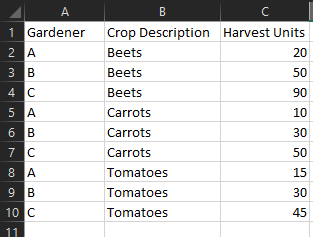
Public Sub CreatePivotTableAndCharts()
Dim PCaches As PivotCaches
Dim PCache As PivotCache
Dim NewWS As Worksheet
Dim PTables As PivotTables
Dim PTable As PivotTable
Dim PChartShape As Shape
Dim PChart As Chart
Dim PChartSheet As Chart
'Create PivotCache
Set PCaches = ThisWorkbook.PivotCaches
Set PCache = _
PCaches.Create(xlDatabase, ThisWorkbook.Worksheets(1).Range("A1").CurrentRegion)
'Create PivotTable
Set NewWS = ThisWorkbook.Worksheets.Add
Set PTables = NewWS.PivotTables
Set PTable = PTables.Add(PCache, NewWS.Range("A1"))
PTable.AddFields RowFields:=Array("Gardener", "Crop Description")
PTable.AddDataField PTable.PivotFields("Harvest Units"), "Sum of Harvest Units", xlSum
'Create Embdedded Chart
Set PChartShape = NewWS.Shapes.AddChart2(XlChartType:=xlColumnStacked)
Set PChart = PChartShape.Chart
PChart.SetSourceData PTable.TableRange1
'Create Sheet Chart
Set PChartSheet = ThisWorkbook.Charts.Add
PChartSheet.SetSourceData PTable.TableRange1
End Sub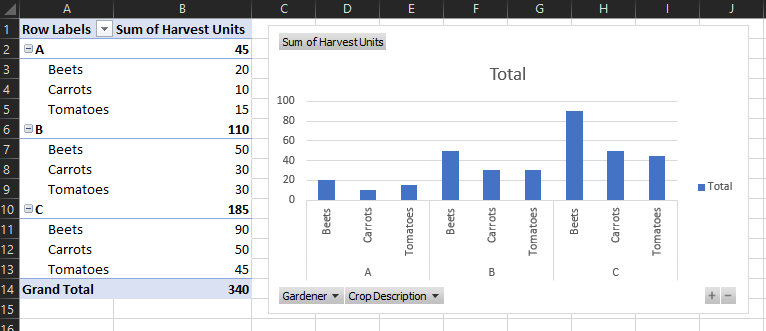
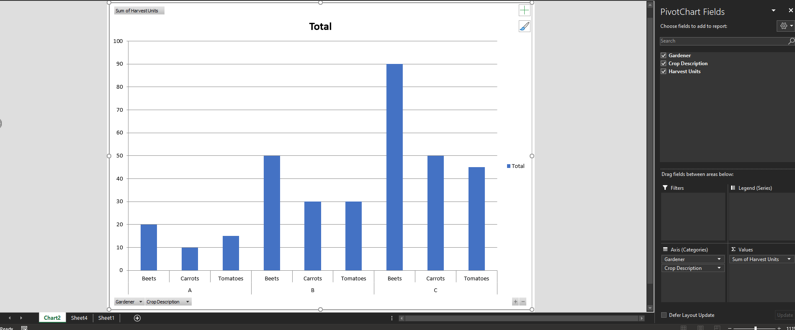
ListObjects
The ListObject class is used to represent a table in Excel. The ListObjects collection object contains all ListObject objects in a Worksheet. Use the Worksheet.ListObjects property to retrieve the ListObjects collection object for a Worksheet. A ListObject can be created using the ListObjects.Add method. Specify the type of data source using the XlListObjectSourceType enum.
Public Sub Example()
'Create table from Range
Dim WS As Worksheet
Set WS = ThisWorkbook.Worksheets(1)
Dim LO As ListObject
Set LO = WS.ListObjects.Add(xlSrcRange, WS.Range("A1").CurrentRegion, , xlYes)
LO.Name = "Table1"
End SubQueryTables
The QueryTable object is used to import source data into Excel. The QueryTables collection object contains all QueryTable objects for a Worksheet. Use the Worksheet.QueryTables property to retrieve the QueryTables collection for the Worksheet. A QueryTable object can be created using the QueryTables.Add method. Provide a connection string for the specific data source when creating a QueryTable.
Public Sub Example()
'Add QueryTable from Excel sheet
Dim ExcelFilePath As String
ExcelFilePath = "C:\example.xlsx"
Dim ConnectionString As String
ConnectionString = _
"ODBC;" & _
"Driver={Microsoft Excel Driver (*.xls, *.xlsx, *.xlsm, *.xlsb)};" & _
"DBQ=" & ExcelFilePath & ";"
Dim WS As Worksheet
Set WS = ThisWorkbook.Worksheets(1)
Dim QT As QueryTable
Set QT = WS.QueryTables.Add(ConnectionString, WS.Range("A1"), "SELECT * FROM [Sheet1$]")
QT.Refresh
End SubPublic Sub Example()
'Add QueryTable from Text/CSV file
Dim WS As Worksheet
Set WS = ThisWorkbook.Worksheets(1)
Dim TextFilePath As String
TextFilePath = "C:\example.csv"
Dim ConnectionString As String
ConnectionString = "TEXT;" & TextFilePath
Dim QT As QueryTable
Set QT = WS.QueryTables.Add(ConnectionString, WS.Cells(1, 1))
WS.Cells.NumberFormat = "@"
With QT
.TextFileConsecutiveDelimiter = False
.TextFileCommaDelimiter = True
.TextFileParseType = xlDelimited
.TextFileTextQualifier = xlTextQualifierDoubleQuote
'MUST Assign TextFileColumnDataTypes to Avoid Data Type Guessing
.TextFileColumnDataTypes = Array(xlTextFormat, xlTextFormat, xlTextFormat)
.Refresh
.SaveData = False
.Delete
End With
End Sub